Chimpanzee Trekking in Uganda takes you for an encounter with man’s closest relative. Chimpanzees are one of the four great apes left on earth. The others are humans, gorillas and oragutans. Apes have no tails but have brains which give them the ability to use advanced tools for survival. After humans, chimpanzees are arguably the most intelligent of the great apes. Their DNA is also the most similar to that of humans. It is because of their intelligence and close resemblance to humans that makes chimps very interesting to tourists.
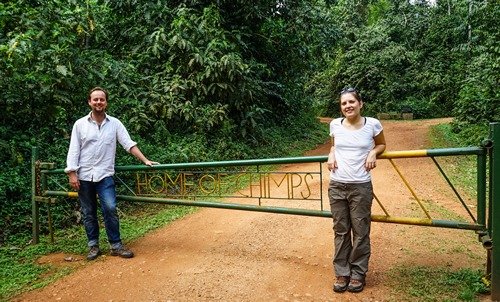 It is important to note that there are two species of chimps. There is the common chimpanzee and bonobos (pygmy chimpanzees). Primatologists like Jane Goodall found out that the two species of chimpanzee differ in stature, location and diet. The common chimps are more numerous than bonobos but both are categorized as endangered by the International Union for Conservation of Nature(IUCN). Chimpanzees normally live in dense forests with a diet that comprises of fruits, leaves, shoots and occasionally meat from smaller animals like rodents or monkeys. They live in a community of between 10 to 100 individuals with an alpha male as leader. The alpha male does not lead for long like in the case of gorillas because there are many more adult males waiting to challenge him.
It is important to note that there are two species of chimps. There is the common chimpanzee and bonobos (pygmy chimpanzees). Primatologists like Jane Goodall found out that the two species of chimpanzee differ in stature, location and diet. The common chimps are more numerous than bonobos but both are categorized as endangered by the International Union for Conservation of Nature(IUCN). Chimpanzees normally live in dense forests with a diet that comprises of fruits, leaves, shoots and occasionally meat from smaller animals like rodents or monkeys. They live in a community of between 10 to 100 individuals with an alpha male as leader. The alpha male does not lead for long like in the case of gorillas because there are many more adult males waiting to challenge him.
Where are chimpanzees found?
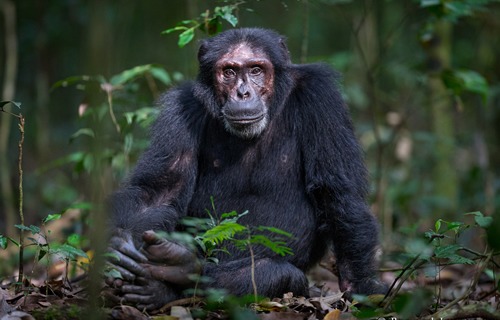 Chimps are found in East, West, Central and Southern Africa. There are also some found in Eastern Asia. Bonobos are only found in the great rain-forests of the Democratic Republic of Congo. Though the overall population of chimps is high compared to gorillas, there numbers have reduced significantly in the last 70 years. Most of this decline is attributed to human activities. As humans encroach on forests, chimps find themselves cornered and with no place to call home. They are eventually forced to raid human gardens for food leading to conflicts with humans.
Chimps are found in East, West, Central and Southern Africa. There are also some found in Eastern Asia. Bonobos are only found in the great rain-forests of the Democratic Republic of Congo. Though the overall population of chimps is high compared to gorillas, there numbers have reduced significantly in the last 70 years. Most of this decline is attributed to human activities. As humans encroach on forests, chimps find themselves cornered and with no place to call home. They are eventually forced to raid human gardens for food leading to conflicts with humans.
![]() Uganda is one of the few countries that still has large populations of chimps. The Uganda Wildlife and Forest Authorities are working hard to conserve the primates in partnership with organizations like the Jane Goodall Institute. One of the methodologies used to conserve and protect these intriguing primates is to promote chimpanzee trekking. Chimpanzee trekking is a tourism activity where visitors track the primates and interact with them in their natural habitats. This adventurous activity helps raise awareness globally about the chimps and the need to protect them to avoid extinction. Chimpanzee trekking also helps raise funds which is used for various conservation activities like monitoring, research and treatment of the primates.
Uganda is one of the few countries that still has large populations of chimps. The Uganda Wildlife and Forest Authorities are working hard to conserve the primates in partnership with organizations like the Jane Goodall Institute. One of the methodologies used to conserve and protect these intriguing primates is to promote chimpanzee trekking. Chimpanzee trekking is a tourism activity where visitors track the primates and interact with them in their natural habitats. This adventurous activity helps raise awareness globally about the chimps and the need to protect them to avoid extinction. Chimpanzee trekking also helps raise funds which is used for various conservation activities like monitoring, research and treatment of the primates.
Chimpanzee Trekking in Uganda
With an overall population of over 5000 chimpanzees, Uganda is regarded as the best destination for chimpanzee trekking. Chimpanzee communities are live in both large and small patches of forests spread ![]() around the countryside. Each forest/destination offers a different experience because of the unique landscapes and atmosphere. The main chimpanzee trekking destinations are Kibale forest national park, Kyambura gorge in Queen Elizabeth national park, Budongo forest within Murchison conservation area, Toro-Semliki wildlife Reserve and Kalinzu Forest. Chimpanzees can also be sighted in Bugoma forest, the Ngamba Island Chimpanzee Sanctuary and Entebbe zoo. Let’s now discuss the chimpanzee tracking destinations in more detail.
around the countryside. Each forest/destination offers a different experience because of the unique landscapes and atmosphere. The main chimpanzee trekking destinations are Kibale forest national park, Kyambura gorge in Queen Elizabeth national park, Budongo forest within Murchison conservation area, Toro-Semliki wildlife Reserve and Kalinzu Forest. Chimpanzees can also be sighted in Bugoma forest, the Ngamba Island Chimpanzee Sanctuary and Entebbe zoo. Let’s now discuss the chimpanzee tracking destinations in more detail.
Kibale Forest National Park: This tropical rainforest is located in the western part of Uganda, a few miles away from the city of Fort Portal. Kibale National Park is best known as one of the top habitats for chimpanzees in Africa. The park has over 1500 chimpanzees. Apart from chimps, Kibale forest also has 12 other species of smaller primates. The smaller primates in Kibale forest include grey-cheeked mangabey, red-tailed monkey, pottas monkeys, colobus monkeys (black and white), bush babies and blue monkeys.
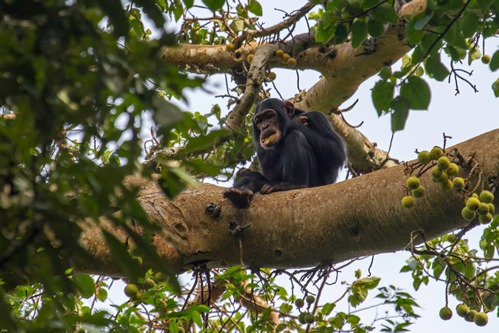 Despite having 12 other primates, Chimpanzee trekking in Kibale forest is the main tourist activity in the park. Four chimpanzee communities have been earmarked for tourism and a permit costs $200 per person. Tourists can choose to track in the chimps early in the morning, mid-morning or in the afternoon. The activity can last anywhere between 2 to 6 hours. Tourists only have one hour of observing the primates and taking photos. To fully enjoy the experience, one must set aside 3 days. A 3 days chimpanzee trekking tour in Kibale will allow you explore the forest in full. Apart from interacting with the chimps, you would have also explored the forest through nature walks and visiting the amazing Bigodi Wetlands sanctuary.
Despite having 12 other primates, Chimpanzee trekking in Kibale forest is the main tourist activity in the park. Four chimpanzee communities have been earmarked for tourism and a permit costs $200 per person. Tourists can choose to track in the chimps early in the morning, mid-morning or in the afternoon. The activity can last anywhere between 2 to 6 hours. Tourists only have one hour of observing the primates and taking photos. To fully enjoy the experience, one must set aside 3 days. A 3 days chimpanzee trekking tour in Kibale will allow you explore the forest in full. Apart from interacting with the chimps, you would have also explored the forest through nature walks and visiting the amazing Bigodi Wetlands sanctuary.
Kalinzu Forest: Nestled a few miles away from Queen Elizabeth national park, Kalinzu forest is one of the best places to observe chimpanzees in their natural setting. Kalinzu has over 290 chimpanzees and 70 of them are habituated. With a high concentration of chimpanzees, the chances of seeing the primates is 90%. The only drawback to chimpanzee trekking in Kalinzu forest is that the tourism infrastructure in the area is not as well developed as in other destinations. When visitors arrive at the forest, things look to be laid back with no sense of urgency. The main reason for the neglect is that the forest is still managed by Ministry of Forestry and not the Uganda Wildlife Authority which has more expertise and resources. The chimpanzees in Kalinzu are only seen as a part of a larger conservation drive. The only good news is that you have a very high chance of spotting the chimps and at a far lower cost of $35 per individual.
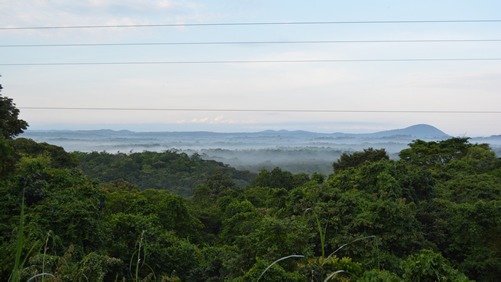 Kalinzu forest is close to Queen Elizabeth National Park and hence you don’t need to worry about accommodation. You can simply book with one of the fine lodges in Queen Elizabeth and drive to Kalinzu only to see the chimps. It is important to note that Kalinzu forest does not only have chimpanzees but also other wildlife species. The forest is home to over 410 species of birds, smaller monkeys, reptiles, butterflies and unique tree species. To enjoy these other offerings, you can simply register for a guided nature walk around the forest.
Kalinzu forest is close to Queen Elizabeth National Park and hence you don’t need to worry about accommodation. You can simply book with one of the fine lodges in Queen Elizabeth and drive to Kalinzu only to see the chimps. It is important to note that Kalinzu forest does not only have chimpanzees but also other wildlife species. The forest is home to over 410 species of birds, smaller monkeys, reptiles, butterflies and unique tree species. To enjoy these other offerings, you can simply register for a guided nature walk around the forest.
Budongo Forest: This forest is found within the larger Murchison falls conservation area. Budongo forest covers an area of 825km2 and hence perfect for chimpanzees. There are about 800 chimpanzee living in this forest. The tall mahogany trees allow the chimps to patrol the forest with ease while enjoying fruits from the shorter trees. Out of the 800 chimpanzees, 100 are habituated and earmarked 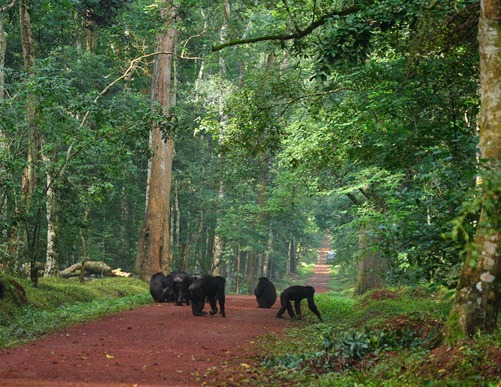 for tourism. Chimpanzee tracking in Budongo forest is done at a place called Kaniyo Pabidi. This part of the forest provides the most ideal environment for the primates. Kaniyo Pabidi is pristine and beautiful for nature walks and birding too.
for tourism. Chimpanzee tracking in Budongo forest is done at a place called Kaniyo Pabidi. This part of the forest provides the most ideal environment for the primates. Kaniyo Pabidi is pristine and beautiful for nature walks and birding too.
There are two chimpanzee trekking sessions in Budongo forest. The morning session starts at 7am and the afternoon session at 2pm. Chimpanzee trekking permits go for $85 and this can be paid on arrival. The best time for chimpanzee trekking in Budongo is during the wet season (April to May and October to November). During the wet season, the chimpanzees are less mobile because there is plenty of fresh fruits in the forest. In the dry season, the chimpanzees can be hard to find because they migrate deep into the forest looking for food. Finding them requires hiking for long hours.
Kyambura Gorge: If you are wondering where to see big game and chimps at the same time, think no further than Kyambura Gorge. Kyambura Gorge is a wide magnificent valley comprising of tropical rain ![]() forest on the eastern side of Queen Elizabeth national park. The valley/underground forest is home to about 30 habituated chimps. Chimpanzee trekking in Kyambura gorge is even more thrilling when combined with nature walks or bird watching. The gorge has a variety of bird species including the African Finfoot, falcons, blue-headed bee-eater and more. Apart from chimps, the gorge is also home to small primates like baboons, bush babies, red-tailed monkeys and Angola colobus. Chimpanzee permits in Kyambura gorge cost $50 per person.
forest on the eastern side of Queen Elizabeth national park. The valley/underground forest is home to about 30 habituated chimps. Chimpanzee trekking in Kyambura gorge is even more thrilling when combined with nature walks or bird watching. The gorge has a variety of bird species including the African Finfoot, falcons, blue-headed bee-eater and more. Apart from chimps, the gorge is also home to small primates like baboons, bush babies, red-tailed monkeys and Angola colobus. Chimpanzee permits in Kyambura gorge cost $50 per person.
![]() Semuliki Wildlife Reserve: Little known by chimpanzee lovers, Semuliki Wildlife reserve is situated along the border between Uganda and the Democratic Republic of Congo. The chimpanzees in the reserve are being studied by primatologists from Indiana University. One of their major findings was that chimpanzees in Semuliki have a peculiar behavior of leaving the safety of the dense forests in the park to forage in the open savanna. The overall population of chimps in Semuliki wildlife reserve is about 260 individuals living in 3 communities.
Semuliki Wildlife Reserve: Little known by chimpanzee lovers, Semuliki Wildlife reserve is situated along the border between Uganda and the Democratic Republic of Congo. The chimpanzees in the reserve are being studied by primatologists from Indiana University. One of their major findings was that chimpanzees in Semuliki have a peculiar behavior of leaving the safety of the dense forests in the park to forage in the open savanna. The overall population of chimps in Semuliki wildlife reserve is about 260 individuals living in 3 communities.
Ngamba Island Chimpanzee Sanctuary: This chimpanzee sanctuary is located on one of the 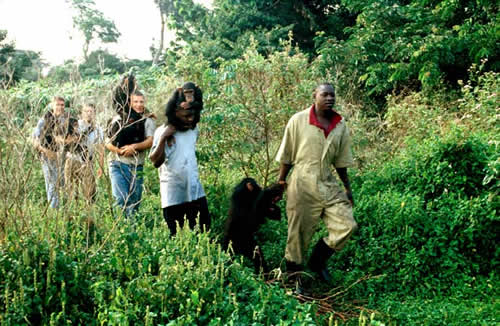 islands in Lake Victoria. The Ngamba Island Chimpanzee Sanctuary was established to rescue orphaned and injured chimpanzees from the different habitats around the country. The chimpanzee at Ngamba Island live in a beautiful but fenced tropical forest covering half of the island. They are catered for by experienced caretakers, volunteers and researchers. One can register to volunteer at the sanctuary for a long time or as a caretaker for the day to get very close to the chimps. Normal visitors can only watch the primates being fed from a distance.
islands in Lake Victoria. The Ngamba Island Chimpanzee Sanctuary was established to rescue orphaned and injured chimpanzees from the different habitats around the country. The chimpanzee at Ngamba Island live in a beautiful but fenced tropical forest covering half of the island. They are catered for by experienced caretakers, volunteers and researchers. One can register to volunteer at the sanctuary for a long time or as a caretaker for the day to get very close to the chimps. Normal visitors can only watch the primates being fed from a distance.
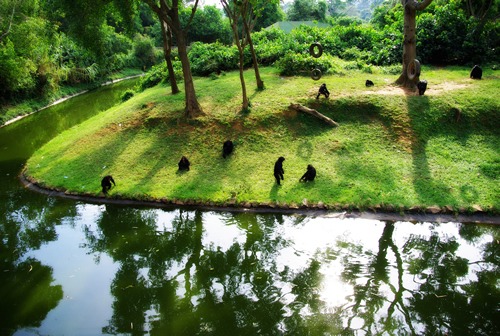 The Uganda Wildlife education centre: This centre is located in Entebbe town and was previously known as Entebbe zoo. At first, it served as a rehabilitation centre for injured, lone and orphaned animals. It was later turned into a zoo so that people could go to the centre to see and learn about the wildlife in Uganda. The Uganda wildlife education centre has 40 chimpanzees and these live in a fenced area with a few trees in it. It is the most convenient place to see chimps and is an excellent destination for those who are in the country for a short visit or a workshop.
The Uganda Wildlife education centre: This centre is located in Entebbe town and was previously known as Entebbe zoo. At first, it served as a rehabilitation centre for injured, lone and orphaned animals. It was later turned into a zoo so that people could go to the centre to see and learn about the wildlife in Uganda. The Uganda wildlife education centre has 40 chimpanzees and these live in a fenced area with a few trees in it. It is the most convenient place to see chimps and is an excellent destination for those who are in the country for a short visit or a workshop.
Comparing gorilla and chimpanzee trekking
Due to the fact that the chimpanzees and gorillas belong to the same ape family, comparisons are bound to occur in areas like how it feels to track them in the wild. Chimpanzee trekking and gorilla trekking 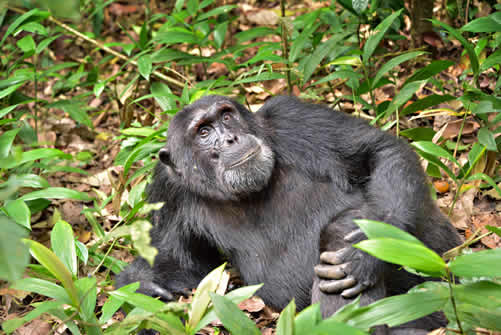 have many similarities and also differences. They offer different experiences and travelers are advised to choose a package that involves both activities. What are the differences and similarities?
have many similarities and also differences. They offer different experiences and travelers are advised to choose a package that involves both activities. What are the differences and similarities?
For starters, mountain gorillas are found in only three countries – Rwanda, Uganda and the Democratic Republic of Congo. Chimpanzees are more widespread and can be found in many tropical rain forests in Africa. They are also found in Asia. Because chimps are more widespread, there are many more places where you can see them compared to gorillas.
Chimpanzee trekking permit go for between $35 to $200 per person depending on where you track them in Uganda. On the other hand, gorilla permits cost $700 per person. If you choose to do gorilla trekking in the Volcanoes National Park of Rwanda, permits will cost $1500. It is important to note that mountain gorilla permits in Uganda can only be acquired from the Uganda Wildlife Authority. 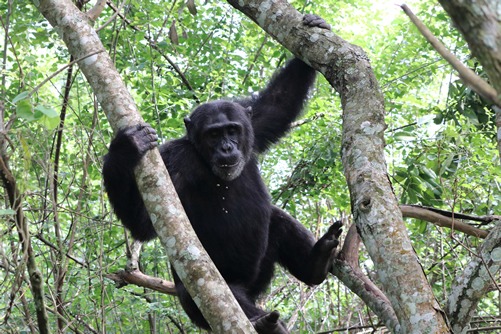 Chimpanzee permits are not always acquired from the Uganda Wildlife Authority because they don’t control all the forests in Uganda (An example is Kalinzu forest).
Chimpanzee permits are not always acquired from the Uganda Wildlife Authority because they don’t control all the forests in Uganda (An example is Kalinzu forest).
Unlike gorillas, chimpanzees tend to spend more time on tree tops. This is because they weigh less and are more agile than gorillas. Gorilla can climb trees too but prefer to stay on the ground as they grow in size. This implies that you can expect to come closer to the gorillas and take better photos compared to chimps. While tracking chimps, you might need binoculars in case they remain on top of the tall trees.
Chimpanzees are normally found in low lying flat lands with dense forests whereas mountain gorillas tend to live in highlands or mountainous areas with dense forests. Because of this, chimpanzee trekking is a less challenging activity compared to gorilla trekking.
While tracking chimps, tourists will have to contend with a lot of noise because the primates are very loud by nature. Gorillas prefer to feed and do their things quietly. They are gentle and peaceful ![]() compared to chimps. It is important to note that because of their loud vocals, the location of chimps can easily be identified from miles away. Gorillas are quiet and you cannot know which area of the forest they are in.
compared to chimps. It is important to note that because of their loud vocals, the location of chimps can easily be identified from miles away. Gorillas are quiet and you cannot know which area of the forest they are in.
Chimpanzee are not so nomadic. They tend to spend time in the same area. Travelers may not need to search for them for too long. This is not often the case with gorillas. Some gorilla groups are very mobile and finding them may take a long time. It is important to note that this is just a generalization. There are many gorilla groups that live close to the park offices and do not move about much.
![]() One interesting thing about chimpanzee trekking is that it can be organized in three sessions. There is the early morning, mid-morning and afternoon session. Gorilla trekking can only be done once a day and must start in the morning.
One interesting thing about chimpanzee trekking is that it can be organized in three sessions. There is the early morning, mid-morning and afternoon session. Gorilla trekking can only be done once a day and must start in the morning.
Only six tourists are allowed to encounter a particular chimpanzee community per tracking session whereas 8 people are permitted to track each gorilla family in a day. After finding gorillas, tourists only have one hour in which to observe them. During chimpanzee tracking, visitors may be allowed more than one hour with the primates.
Chimpanzee Trekking rules in Uganda
- One must possess a chimpanzee permit in order to be allowed to take part in the activity. It is important to book the permits in advance to avoid missing out. This is especially true for those who are interested in traveling during the peak seasons or in Kibale National Park.
- Persons under the age of 13 years are not allowed to take part in chimpanzee trekking.
- Travelers with a contagious disease like a cold, flu, cough, covid-19 and cholera are not allowed to track chimps.
- Always adhere to the guidelines stipulated by the ranger during the initial briefing
- Littering is not allowed in the forest.
- Eating while with the chimpanzee is discouraged because the primates may grab the food from you. They may also eat the remains after you leave which can turn catastrophic if a traveler had an infectious disease.
- Always keep a 7 meter gap between you and the nearest chimpanzee.
- Flash cameras are prohibited for photography and taking videos of the chimps.
- Noise and mimicking the chimpanzees is strongly discouraged.
- Only six people are allowed to visit each chimpanzee community per session.
Packing list for chimpanzee tracking in Uganda
- For the best chimpanzee tracking experience, consider packing study leather shoes.
- The clothes you choose for your trip must be suitable for Africa’s jungles. They should be dark green, grey or brown in color. The clothes should be covering most of your body parts to avoid thorns and shrubs.
- To avoid getting thirsty or hungry ensure that you have light snacks with bottled drinking water.
- A good camera and a pair of binoculars is a must if you wish to have the best experience with the chimps. You don’t want to go back home with no proof of your adventures with the primates.
- You will require a walking stick to aid you while hiking though the dense forests and steep trails.
- Don’t forget to hire a porter if you plan to carry a heavy bag or camera equipment. The porters can also help you when climbing difficult parts of the forest.
- Other items to consider including in your packing list include an insect repellent to prevent insect bites, a sanitizer to clean your hands and a face mask.


